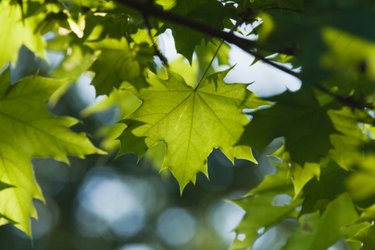
Various caterpillars consume maple leaves. They usually occur in periodic outbreaks of a few years at a time, though the interval between outbreaks and how long that outbreak lasts depends on the species and environmental conditions. Healthy maples often recover, suffering only decreased growth and some dieback. Repeated years of defoliation or defoliation suffered by a weakened tree can result in death.
Forest Tent Caterpillar
Video of the Day
Forest tent caterpillars (Malacosoma disstria) are approximately 2 inches long with dark bodies, footprint or keyhole-shaped marks on their backs, narrow orange lines with pale blue stripes on their sides and conspicuous body hairs. Unlike other tent caterpillars, they spin silken mats -- not true tents -- on tree boles and at the base of large limbs. Adults lay eggs in circular masses around small twigs. Damage is usually limited to crown dieback and reduced growth, but sugar maples will also experience a decline in sap yield and quality the following spring. If they experience extensive dieback, sugar maple sap will suffer for several years. Trees usually recover their foliage in five to six weeks.
Video of the Day
Fall Cankerworm
Fall cankerworms (Alsophila pometaria) are also known as inchworms, loopers and measuring worms in their larval, or caterpillar, stage. Red maples are among their preferred hosts; larvae feed in the spring and adults are active in the fall. Mature caterpillars are almost precisely 1 inch long with light green or dark brownish-green bodies. Light green specimens have white lines from their heads to the tips of their abdomens; dark green specimens have a black stripe running down their entire back. The more dark green caterpillars there are, the heavier the infestation. Young larvae do not consume entire leaves, but their mature counterparts do. Together, a healthy population can easily defoliate an entire tree. If this occurs two years in a row, maples can die.
Greenstriped Mapleworm
Maples of various species are the preferred hosts of greenstriped mapleworms (Dryocampa rubicunda), but they will also feed on box elders or certain oaks if necessary. Adult females lay eggs in May on the undersides of leaves, which emerge as black-headed caterpillars with creamy yellow bodies and green stripes. When young, they feed en masse and consume entire leaves. As they mature, their appearance changes to a caterpillar with a cherry-red head and yellow-green body with seven dark green lines running down its side. Two long black spines also emerge on the second segment of the thorax. Damage to maples by the greenstriped mapleworm is primarily aesthetic and trees usually recover.
Saddled Prominent
Saddled prominent (Heterocampa guttivitta) is almost always found in a population of other defoliator insects, such as the greenstriped mapleworm, the whitemarked tussock moth and several species of loopers. Of the maple species, the saddled prominent prefers sugar maples. Mature caterpillars are a little less than 1 1/2 inches long and usually have green bodies with a red saddle-like mark in the center of their backs, though they can also be entirely reddish brown or lack the saddle marking. Their heads also have a distinctive pattern: one dark brown stripe, two yellow or white stripes and one pink stripe. Healthy dominant or codominant maples usually survive the extensive defoliation these outbreaks create, but those in the understory often don't make it. Of those that survive, crown damage can be extensive and the trunk will expand its diameter 50 percent less than normal during defoliation.
- Cornell Sugar Maple Research and Extension Program: Forest Tent Caterpillar (Malacosoma disstria)
- Pennsylvania State University; Fall Cankerworm; Gregory A. Hoover, Sr., et.al.; August 2010
- Auburn University; Greenstriped Mapleworm; L.L. Hyche; February 2000
- Cornell Sugar Maple Research and Extension Program: Saddled Prominent (Heterocampa guttivitta)